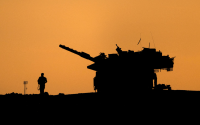U.S. Deaths from Enemy Fire at Highest Level Since Vietnam
Published on Saturday, April 17, 2004 by Knight-RidderDrew Brown
With fighting in Iraq now at its worst, the number of U.S. troops killed by enemy fire has reached the highest level since the Vietnam War.
The first part of April has been the bloodiest period so far for U.S. troops in Iraq. There were 87 deaths by hostile fire in the first 15 days of this month, more than in the opening two weeks of the invasion, when 82 Americans were killed in action.
"This has been some pretty intense fighting," said David Segal, director of the University of Maryland's Center for Research on Military Organization. "We're looking at what happened during the major battles of Vietnam."
The last time U.S. troops experienced a two-week loss such as this one in Iraq was October 1971, two years before U.S. ground involvement ended in Vietnam.
There are 135,000 U.S. troops in Iraq. Nearly 700 American troops have died since the beginning of the war. As of Friday, 493 had been killed by hostile fire.
The Vietnam War started with a slower death rate. The United States had been involved in Vietnam for six years before total fatalities surpassed 500 in 1965, the year President Lyndon B. Johnson ordered a massive buildup of forces. There were 20,000 troops in Vietnam by the end of 1964. There were more than 200,000 a year later.
By the end of 1966, U.S. combat deaths in Vietnam had reached 3,910. By 1968, the peak of U.S. involvement, there were more than 500,000 troops in the country. During the same two-week period of April that year, 752 U.S. soldiers died, according to a search of records kept by the National Archives.
U.S. officials say that comparisons with Vietnam are invalid and reject the idea that Iraq has become a quagmire.
But the two-front battle that U.S. troops have been waging against Sunni and Shiite insurgents for the past two weeks is the most widespread resistance U.S. forces have faced since the war in Iraq began.
Senior U.S. officials insist the current fighting is only a "spike" and not indicative of a widening war. On Thursday, Gen. Richard B. Myers, chairman of the Joint Chiefs of Staff, described the current fighting as a "symptom of the success" U.S. forces are having in Iraq. "The sole intent" of the insurgents is to stop Iraq's transition to self-governance and democracy, he said.
Defense Secretary Donald H. Rumsfeld said Thursday that the death toll was worse than he had expected a year ago.
He also announced that more than 20,000 troops, mostly from the 1st Armored Division, would remain in Iraq for three more months to deal with the insurgency instead of coming home after a year of duty.
Gunfire has been the biggest killer of U.S. troops, followed closely by improvised explosive devices. The two account for more than 250 deaths.
Those killed represent a wide range of military specialties. Truck drivers and clerks are getting killed just as often, if not more often, than infantrymen and other combat specialties.
That's an indication of the kind of battlefield environment in Iraq.
"Even Vietnam was a more conventional war than this," said Charles Moskos, a sociologist with Northwestern University who specializes in military issues and worked as a correspondent in the Vietnam War.
"Here in Iraq, there are no battle lines," he said. "It's all over."
Another striking difference is age.
The average age of a casualty in Vietnam was 20 years old. The average age of a casualty in Iraq is nearly 27. The youngest American soldier killed in Iraq was 18; the oldest was 55.
More than 12 percent of those killed have come from the Army National Guard and Army Reserve, which helps explain why the average age of the dead is higher.
"Reserve components tend to be older," Moskos said. Another reason is that a number of special operations troops were also killed in the early days of the war, and they tend to be older as well.
The dead were from all 50 states, plus the District of Columbia, Puerto Rico, American Samoa and the Marianas, a U.S. protectorate.
California has 75 dead; Texas, 67; Pennsylvania, 36; and Michigan, 22.
Nearly one-third came from the South, including 22 from Florida and 18 from Georgia.
Nearly 70 percent were white, according to Pentagon figures from April 8, the last date for which those statistics were available. Twelve percent were Hispanic, and 14 percent were black. Asians and other races accounted for less than 6 percent.
In a sharp departure from previous wars, 18 women have been killed, 12 of them by hostile fire, including a civilian lawyer working for the Army.
Sixty-five percent of those killed have been from the Army, which has had the most troops in Iraq. Twenty percent were from the Marine Corps, which has taken more than half of the casualties in April because of fierce fighting in Fallujah.
Many of those killed were from small towns and inner cities, rather than the suburbs, Moskos said.
Hostile fire has accounted for about 70 percent of the deaths in Iraq, according to figures compiled by the Pentagon and www.lunaville.org, an independent Web site that tracks coalition casualties.
In all, 88 U.S. troops died in the first 15 days of April, including one whose death wasn't caused by hostile fire. In the first two weeks of the war, 98 died, including 16 from non-hostile causes.
Since Vietnam, there was one attack on U.S. forces that inflicted a higher death toll than anything experienced since: 241 servicemen were killed in Beirut in 1983 when a suicide bomber from the Islamic group Hezbollah drove a truck full of explosives into their barracks.
Many experts and historians cite that incident as the beginning of America's war with Islamic terrorists.
http://www.commondreams.org/cgi-bin/print.cgi?file=/headlines04/0417-02.htm






